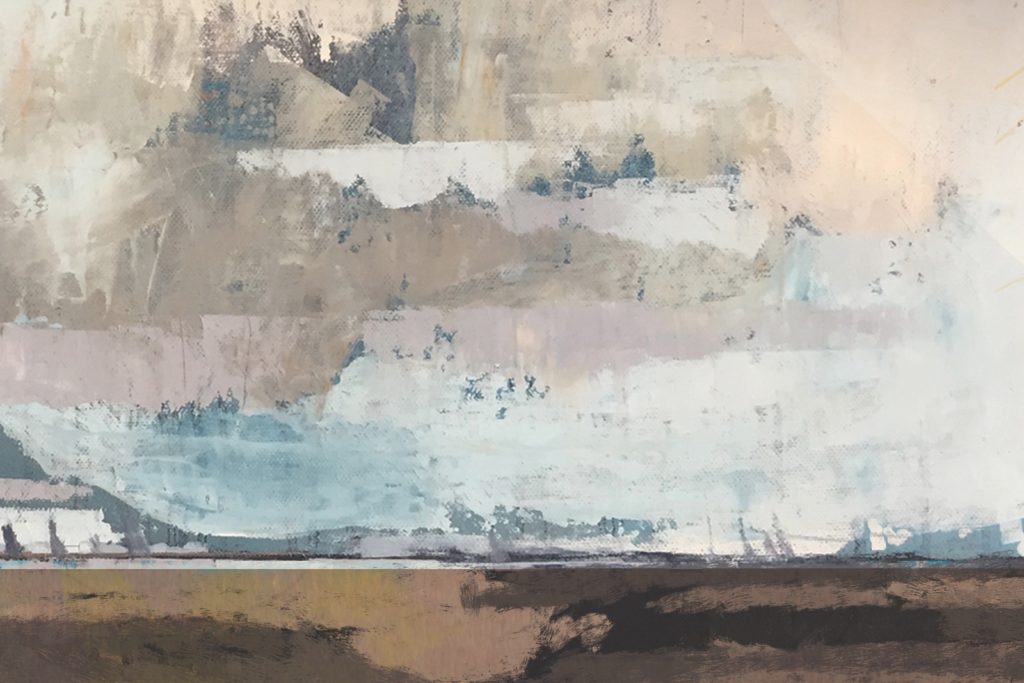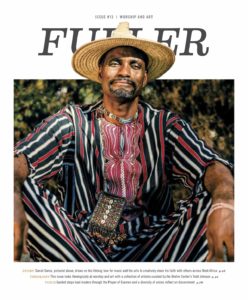
Given the time to create art as part of their seminary training, many students in Fuller’s Capstone Theology and Art course explore, expand, or improve areas that, in their estimation, Christian theology has failed to satisfactorily engage. Hence, their thesis projects fall in line with philosopher Simone Weil’s conclusion that “creative attention means really giving our attention to what does not exist.”1 These students’ imaginative and physical negotiations subsequently yield a heftier sense of God, others, and self. For this reason, I have found that the paired investigations of art and theology enhance student formation, doing so in the following ways.
WHOLE-BODY INTELLECT
Pairing the investigation of art and theology exercises a whole-body intellect that includes the somatic and affective realm. Because of the concrete nature of art making, these thesis projects fill a void left by disembodied practices of the Christian faith. These nascent theologians ask, why do believers profess one thing but do the opposite or nothing at all? Why is theology often abstract to the point of ignoring actual human circumstances or experiences? Ethicist James McClendon once expressed that Christians have falsely believed that ethics has nothing to do with “our bodies, their environment, our mutual needs, our delights and horrors, our organic selfhood in context.”2 By contrast, Capstone student Caitlyn Ference-Saunders’s project employed these features as a means to theologically investigate the virtues of the historical church. Drawing on her theater training, she led a band of committed seminarians through devised theater and performance-based exercises. Over a period of six months, the community-building program also produced a vocabulary of movements, vocal phrases, and impassioned narratives that culminated in a choreographed performance piece entitled Rehearsing the Virtues of God: A Story of Faith and Fortitude. Her project echoed the conclusion of Matthew Crawford, who argues that “real knowledge arises through confrontations with real things.”3 Through Ference-Saunders’s thesis, the Christian practice of regularly meeting together to confront “real things” was broadened to include external play as a means to connect to inner life.
PROFOUND ANALYSIS
Theological and creative exploration not only accesses whole-body wisdom, but also applies a more thorough approach whereby praxis informs theory and vice versa. This is one of the modalities of Hispanic/Latinx theology that links theological analysis conjunto with agencies stemming from embodied contextual realities. This type of theological practice invites cultural sources—life lived in the flesh—to drive analysis toward liberating acts. In fact, when it comes to problem solving, artist Theaster Gates notes that creative operations become the means to “master the [art] form,” which also enables persons to “understand the world.” Gates’s activity of constructing cultural venues by renovating abandoned buildings in Chicago’s South Side informed his knowledge of building construction, the urban landscape, and negotiating the bureaucratic. In the spirit of Fluxus artist Joseph Beuys, Gates poses the question to all: “Could the artist consider herself inside a bigger problem, and as a result bring aesthetics, bring taste, bring passion, and bring form” as part of the solution?4 If the artist is open, the devising and the formal qualities of the art will inform maker and viewer in relevant and revelatory ways. This kind of exploration ultimately leads to transformation.
BRIDGING THE SACRED AND SECULAR
The integrative qualities of the Capstone thesis project also endeavor to bridge the social worlds belonging to the secular and sacred. This was the case in Hyung-in Kim’s project. Grounded in concepts of trinitarian theology, Kim used the visual motif of the braid to deal with issues of alienation, race, and cultural diversity. The project consist- ed of two parts. In the first stage, Kim directed a series of creative workshops to explore these concerns through conversations with teams of three held in conjunction with their choreographed entwining of long strands of fabric. The array of fabric choices by color and pattern alluded to the possibility of differences tightly dwelling together as a unified entity. Developed for various ages, the sessions took place at conferences, Christian gatherings, and schools. For the second stage, all of the braided chords were collected to create an installation piece entitled Remem-bearing as Refugees. After its initial display in a church, it was exhibited in multiple secular and Christian contexts.
The Capstone Theology and Art course provides an avenue for embodied demonstrations of faithfulness, inviting collaboration and offering community building opportunities. Through song, video, dramatized story, art installations, poetry, and more, these student endeavors are exploring the intersection of the human and the divine supported by Christ’s incarnation. It is his body that furnishes the capacity for theological exploration with the body, for the sake of all bodies. Somatic theological contemplation reconnects faith with work, the sacred with the profane, the material with the spiritual. While art is not gospel and does not save, it can free the imagination to see the evidence of God’s redeeming hope in the world—in ways that perhaps should become a part of every seminarian’s faith training.


